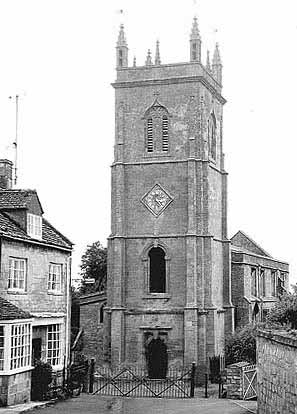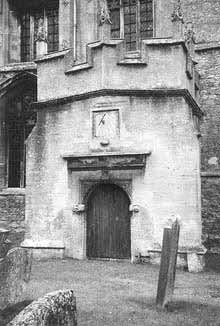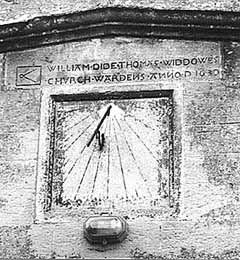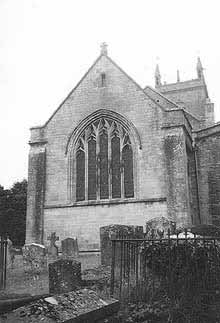
The church is described as having a "spacious nave, and north aisle of the middle ages. The chancel, of the Saxon style, is probably the same structure that is described in the Doomsday Book." In addition to the mother church there were anciently three chapels in the parish of Blockley. One was situated in Blockley Warren, one at Paxford, of neither of which does any trace remain; and the third at Aston. Dugdale, in his Antiquities of Warwickshire, speaking of Stretton-on-Fosse, observes that it was formerly a chapel belonging to the Church of Blockley. For some centuries Blockley was the only place of sepulture for several other adjacent parishes. Nash mentions Bourton-on-the-hill, Moreton-in-Marsh, and Batsford as having formerly buried at Blockley; from which parishes, as well as Stretton-on-Fosse, the Vicar of Blockley formerly claimed mortuaries. The chancel bears many external evidences of its Norman origin in the usual form of shallow buttresses, a corbel table running along its north and south sides beneath the parapet; a Norman window on the north side, the east and south lights having been altered as mentioned in the description of the interior.In the year 1838 the east wall and a portion of the north wall were rebuilt, the foundation stone bearing this inscription: "This stone was laid on the day of the coronation of her most gracious Majesty Queen Victoria, XXVIII June, A.D. MDCCCXXXVIII. on the rebuilding of the north and east walls of this chancel."
Miles Coyle, M.A., Vicar
William Jean, B.A., Curate
J. Westmacott. – W. Philips, Churchwardens
J. Bearcroft, Clerk
R. Hulls, Builder (Gr. son of Jonathan Hulls Inventor
J.M.T. and C Powell, Masons
T. Kingerlee, Plumber
T. Figgures, Plasterer
Over the east window is inserted a Norman loop-hole, and on the gable a plain cross. On the south parapet is the following inscription : "This battlement on the chancel was erected at the voluntary expense of ye Honble Colonel Hunt. Anno Dni. 1738."On the same side is an early pointed priests door. It is evident from the weather moulding above the roof, on the east wall of the naive, that the roof of the chancel has been lowered.The exterior of the sacristy of vestry plainly shows that portion of the north wall has been removed for the purpose of adding this feature, part of the materials of which are used in its construction, the corbel table still remains (1875) within the roof, one similar in character being added to the north wall of the sacristy. The buttresses of this portion are shallow, and the windows narrow and devoid of ornament. the parapet like that of the rest of the church is plain.The south front of the naive has a clerestry of four square-headed windows of three lights each, all of which have a plain label moulding. Four windows of a similar character form the clerestry on the north side. The north aisle is of plain design, and bears signs of alteration. It has an upper series of four small square-headed windows of two lights each, the easternmost being smaller than the others. At the north-west angle is the only diagonal buttress in the building.

 There are two porches, north and south; the latter of which is embattled, and the same style as the tower. It bears a sundial, and has this inscription:
There are two porches, north and south; the latter of which is embattled, and the same style as the tower. It bears a sundial, and has this inscription:
"William Dide,
"Thomas Widdowes,
"Churchwardens, Anno D., 1630."
Within this porch is the original south Norman doorway, enclosing a square-headed tympanum and a pointed arch.The north porch was built by subscription in 1871, at a cost of £36 19s 0d. This porch was added for weather purposes, and to help to shut out as much as possible, during the times of divine service, the noise of the foot traffic which passed close by the original door.In the year 1724 a meeting of parishioners was held for the purpose of making a levy to provide funds for taking down the old tower, which required rebuilding. The cost of taking down the tower (including the removal of the bells) was about £25, the work being done by Mr. Thos. Woodward, a mason, of Chipping Campden, by whom also the erection of the present tower was carried out. It was recommended in 1725, and was continued to completion during the next two years. The first stone was laid by Sir John Rushout, Bart., whose name is inscribed thereon. The present tower, which stands at the west end, consists of four stories, and is somewhat meagre in design, as may be expected from the period in which it was built. It has a door in the west side, above which, on the second story, is a round-headed window. On the third story is a clock dial, and in the upper, a window of two lights on each face of the tower. At each corner is a pinnacle surmounted by a vane, and in the centre of each side a smaller one.It is evident that the materials of the older tower were brought largely into requisition in building the present one; and it is probable, from the appearance, that the lower portion of the eastern wall was not disturbed in rebuilding the tower; the stair turret being clearly constructed from the former one, pieces of Norman shafting and moulding being traceable in many places. From this it is clear that the old tower was of Norman design, and, therefore, much superior in style to the present one. The total cost was borne by the parishioners, and was raised by means of levies made at the rate of so much per yardland. These are entered in the parish book, as follows:From "ye first levy made 9ber 23rd, 1725 00£105 8 0
From "ye second levy made May 17th 1726 £105 8 0
From "ye third levy made 7ber 6th 1726 000£105 8 0
From "ye fourth levy made 9ber 14th 1726 0£104 12 0
From "ye fifth levy made August 1726 0000£101 1 6Of this sum, all was collected except £4 16s 8 1/4dThe sum paid to Mr. Woodward for the erection (as shewn by the receipts signed by him, and entered in the parish book) was £500.In the lower story of the tower are two mutilated effigies (of the Elizabethan period) once recumbent, but now removed from their original position and placed here.In the upper story is a peal of six bells, with the following inscriptions:
1st Bell: Robert Warner and Robert Robbins. Samuel Scattergood Rector, 1683. C. W. M. B.
Carolus II Dei Gratia.
2nd Bell: Alfred Fletcher and William Davis, Churchwardens, 1679.
3rd Bell: Property of this parish A. R. 1729
4th Bell: God save the King, 1638
5th Bell: Henry Baglee made me, 1638.
6th Bell: I and E. Meres, Founders, London. Miles Coyle, Vicar, William Philips, John Hiron, Churchwardens 1854. Glory to God in the highest.
The 3rd bell seems to have been taken to Gloucester in 1729 to be recast. The work was done by Mr. Abraham Redhall (whose initials appear on the bell), and is entered in the parish accounts as follows:"Paid to Mr. Abraham Rudhall for casting the third bell, and for waste and new mettle added to the said bell, and a clapper, £12 8s 6d."Payments to ringers in 1729 in Churchwardens accounts:Paid to John Keen for ringers at gunpowder 0 6 0
At the coronation of King George 0 1 61733:Paid to John Keen for the ringers on the 29th of May 0 3 0The names of the ringers in 1875 were:James Keen, Charles Webb, Joseph Bailey, Charles Keyte, Frederick Webb and Frederick Ellis. |
The Chancel possesses some of the oldest features of the building, and consists chiefly of late Norman work. Its interior measures in length from east to west 32 feet 6 inches, and in breadth 18 feet 6 inches. It was evidently either vaulted with stone, or intended so to be, as appears from the clustered corbel shafts remaining on the north and south walls. Corresponding pillars also remain in the N. E. and S. W. corners. Above the present ceiling are remains of a former open timber roof of high pitch. One Norman window still exists on the north side; the other two which lighted this side being closed with masonry, though indications of their position may be traced; their size corresponding with the one still existing. The east window is pointed and clearly a later insertion. It consists of five lights, with geometric tracery in the head, and is filled with stained glass, in memory of the honourable Elizabeth Grieve.

The south windows have also apparently been altered, those east and west retaining the size of the original Norman openings with their side columns, but the heads converted into pointed arches, with geometric tracery, the lower portion being divided into two lights. The centre window appears to have been entirely altered, and has three lights with perpendicular tracery in the head. Underneath is a square-headed doorway, and by its side a small organ, the gift of the present (1875) Lord Northwick. Under the S. E. window is a handsome piscina and sedilia, of decorated work, the whole series comprising four ogee openings, enriched above with crockets and finials. The piscina is trefoiled in the head with cuspings, and is divided into two compartments by a shelf, which (as also the water receptacle and drain) has lately been restored. The sedilia is a triple one, the shafts dividing the series being detached; the mouldings of the arches being continued to the base of each of the sedilia.Under the east window is a modern (1838) reredos of four compartments of similar design to the sedilia, but of rather inferior material and workmanship. In the north wall opposite to the sedilia, an aumbry, divided by a transome and partitioned into four compartments, was discovered lately (1872) during the replastering of the wall; but it has been bricked in and plastered over again. I think it is to be regretted that this feature was not restored.The chancel arch is of perpendicular work, with plain chamfered mouldings, springing from the original Norman piers supporting a former arch. The lower portion of these piers has been cut away to widen the aperture, in which is a perpendicular oak screen, of three divisions; the central one being open, and without any ornament; the side compartments being divided by open panel work with pierced tracery in the heads; the lower portion consisting of solid panels. The carved work along the top has been lately added. Access to the roof loft was gained by a stair (now closed) in the thickness of the south wall. The roof is plastered internally, and is a plain pointed vault. Its date may probably be 1702, as in that year, William Lloyd, Bishop of Worcester "ceiled and beautified the chancel." Such ceiling and beautifying is very inappropriate, and it is a matter fro regret that the proper timbered roof has never been restored, the greater portion of it being still hidden above the present inappropriate ceiling.During the late alterations and repairs, fragmentary portions of ancient fresco paintings were discovered on both walls and arches, in several layers, indicating that they had been painted at different periods. They were too much mutilated and the material too friable to justify any attempt to preserve them.On the north side of the chancel is a pointed doorway communicating with an early English structure (now used as the vestry) probably anciently used as the chantry founded in honour of the Virgin Mary by Ralph de Baketon in 1320; though it is doubtful whether it was not intended originally as the residence of the priest in charge. This structure consists of two stories; the lower one being lighted by two narrow pointed windows splayed very deeply on the inner sides; one of these is on the north, the other somewhat out of the centre of the eastern wall. In the west wall is a locker; and in the S. E. corner a stone stair (now closed) communicating with the upper chamber. Access is now obtained by means of a wooden stair on the west side. If it were possible to restore the original means of communication, a considerable enlargement of both rooms would be obtained, and their proportions recovered. The lower room is now used as a vestry; the upper one for parish meetings.In this latter is an old oak chest, and some superseded service books; the oldest of which is a folio black letter Bible, temp: James 1st, in its original wooden boards, clasped, and covered with leather; also a very ancient edition of Bishop Jewel's Apology, who died in 1571.The Chantry was endowed by Ralph de Baketon with 2 messuages, and 26 acres of arable land, and 2 of meadow. The deed was confirmed the same year (1320) by the prior and chapter.In the year 1356, 30 Edw. III, John de Blockeleie gave to this chantry, and to John Wilde the chaplain, and his successors, 2 messuages, 54 acres of land, 7 1/2 acres of meadow, 4 acres of pasture, 4 shillings of rent and a rent of 4 hens, and one loaf of a Bushel of corn, with the appurtenances in Hanging-Aston. Deed witnessed by Thomas Clipston, Thomas Child, John Loger and others.John de Blokley again increased the revenues of this chantry by a subsequent gift of 40 Edw. III, when he bestowed on Henry Rose, the chaplain, and his successors, one messuage, a mill, a toft, and an acre of land in Blockley, 5 acres of land in Hanging-Aston, and 27 shillings of rent in Dorne. The witnesses to this deed were John Dychford, John Child, and others. By Henry VIII's original valor of this Diocese in the first-fruits office, it appears that the chantry of the Blessed Virgin in this church was worth yearly £11 11s 7d. In an original valor 26 Hen: VIII, at the same office it is related only at £5 11s. On the 14th February 1375, Bishop Wakefield confirmed the ordination of the chantry of John de Blockley.The body of the church consists of nave and north aisle. The nave measures internally 58 feet in length by 25 feet 6 inches in breadth. It is lighted by three large perpendicular windows on the south side, of three lights each; the easternmost being square headed, the others obtuse pointed. On each side are four debased square clerestory windows, between each of which, the upper part of the walls are thickened inwards on corbelling. On the faces of these portions still remain the brackets which formerly supported the principals of the open timber roof, which doubtless of the usual perpendicular character internally, but covered externally by a roof of more elevated pitch, corresponding with the gable of the east wall of the nave. The present ceiling is of plaster, flat, with circular classical ornaments, all out of character with the building. At the west end is a gallery extending also across the north aisle. The eastern buttresses of the tower project into the nave at the west end, and between them are the piers of a Norman doorway now blocked up. On the south is a porch, of modern date, between which and the church is a somewhat lofty Norman doorway, within which is inserted a late perpendicular square framework enclosing a pointed arch; the spandrils being filled in with appropriate ornament. The pulpit is of oak, Jacobean in design. The font is of stone, of decorated character, octagonal in plan, with quarterfoils on each face, having a four-leaved flower in the centre. Within the moulding, beneath the basin, and above the pedestal is a row of similar ornaments. The base consists of one step only; and a modern carved oak cover serves as a canopy.The north aisle is separated from the nave by four arches with plain chamfered mouldings, supported on hexagonal piers. The original length of this aisle corresponded with the nave, with a width of about eleven feet. It is lighted on the north by four debased windows, with a similar number of smaller ones above them, of like character; and by a small pointed one (much altered) at the west end. It is evident from the existence of a piscina, of somewhat ornamental design, but mutilated, fixed to the north chamfer of the semi-column at the east end of this aisle, and from other indications, what a wall formerly bounded this aisle in a line with the chancel arch, and that under the east window of this aisle, an altar undoubtedly stood. It may be suggested that the chantry chapel founded in honour of St. Mary by Ralph de Baketon in 1320, was transferred to, and occupied this position during the latter period of its existence previous to the Reformation, when all endowments of this kind were diverted into other channels. It is quite clear that the aisle did not originally extend to its present limits, from the fact that its present east and south walls were certainly external walls, as shown by the presence of the corbel tables just below the roof, which correspond with the south wall of the chancel and sacristy adjoining; as well as from the closed Norman window in the chancel wall, before referred to as one of the closed lights. The space by which the north aisle has thus been extended eastward, is now occupied as the vault of the Northwick family. The roof of this aisle, and its extension was restored in 1872, one half (£44 9s 7d) of the expense being borne by Lord Northwick, who has also removed at his own cost, the hideous structures which lately occupied the greater portion of this aisle, and substituted for them open oak seats. The floor has also been newly paved at his Lordship's cost. Formerly the whole of the church was disfigured by high pews, but the present vicar, soon after his appointment to the living, entirely removed them from the north side of the nave, and re-seated it at his own expense. in 1872, the south side, and the chancel were similarly improved, the cost (about £333) being provided by public subscription. At the same time the old stove used for warming the church, and which burned much fuel, but gave little heat, was removed, and a warming apparatus by means of hot water pipes laid down through the building, substituted in the place of it. This apparatus was provided by Messrs Jones and Lowe, of Worcester at a cost of £93 9s, included in the above sum of £333.In the year 1706, Elizabeth Martyn, wife of Francis Martyn, Esq. of Upton Wold, gave a large silver plate for use at Holy Communion; it bears this inscription: "Hanc patinam sacris in ecclesia-de Blockley pro singulari sua pietate dedicavit Dna. Eliz : uxor Fran : Martyn Arm : 1706."In the year 1707, Dame Sarah Shore gave a Communion Table Cloth, and Damask napkin.In the year 1732, the Right Hon. Elizabeth Countess Dowager of Northampton, sister of Sir John Rushout, Bart. of Northwick, gave the Silver Communion Service, now in use, and also a fine Damask Table Cloth, and six napkins. The Communion Service consists of 2 large Flagons, 2 Chalices, 2 Patens, 1 Plates, 1Alms Dish. The Alms Dish has on it this inscription; "This set of Communion Plate was given to ye church of Blockley, by ye Right Honble. Elis. Countess Dowager of Northampton, Anno. 1732. Weight of ye whole set of plate 164oz. 16dwt."The following gifts have been also lately made: Altar Candlesticks, and the lectern lights by Mrs. Bromfield; the Book of Common Prayer, by Mrs henry Grisewood; the Lesson Book by the Rev. H and Mrs. Bromfield; the pulpit lights by the Rev. H. Bromfield; and the small desk light by the Rev. A. J. Soden. The Carpet within the sacrarium, and on the altar step, is of needle-work, executed by parishioners and other friends. The organ (a chamber one) was presented by Lord Northwick, being brought from his Lordship's residence at Cheltenham.
Above material on the Church of St. Peter and St Paul, Blockley from the book The History of Blockley by The Rev. Alfred J. Soden Curate of Blockley, 1875 The floor plan of the church is also from the same book |